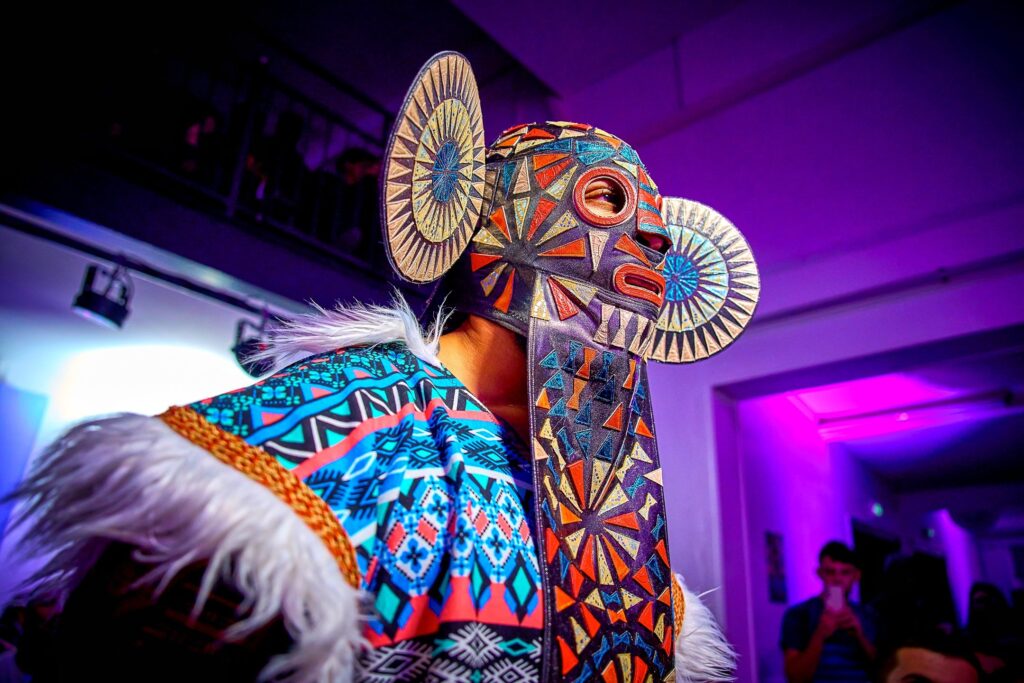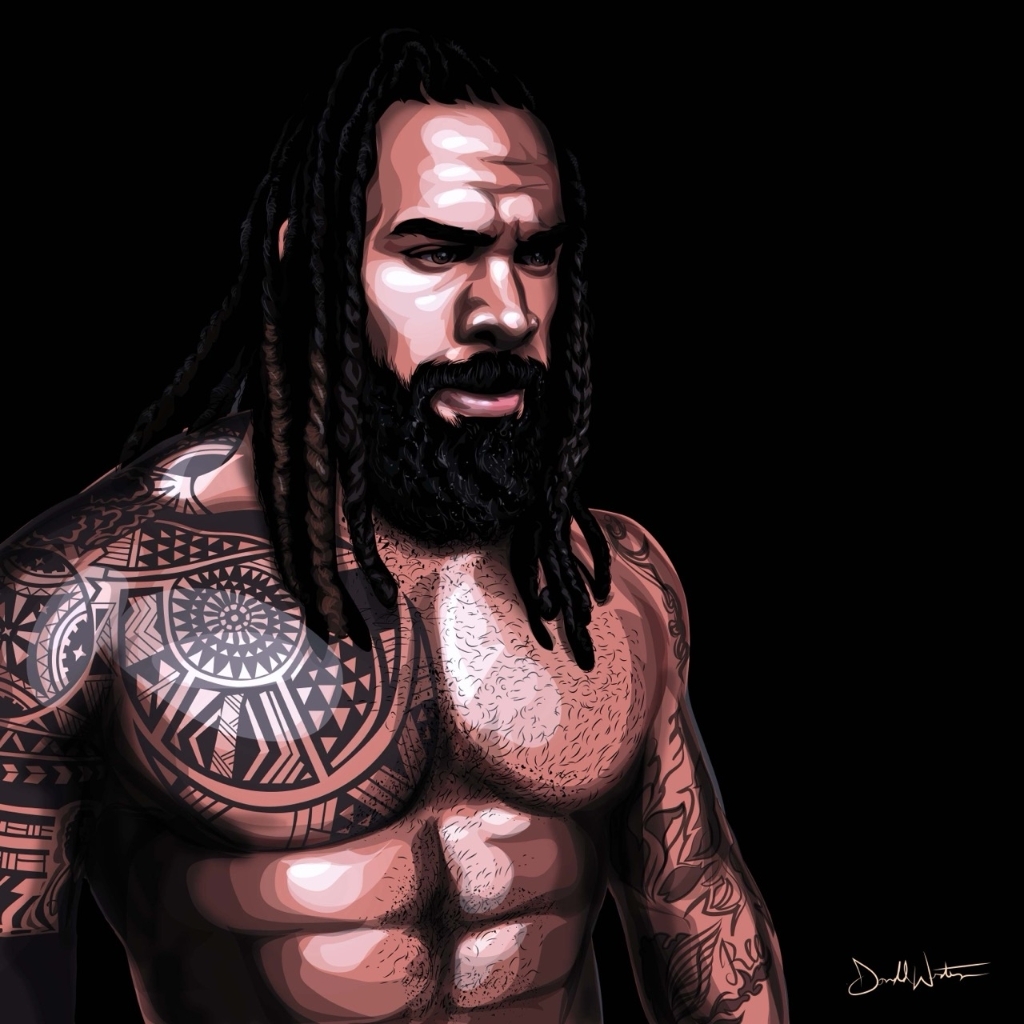Words: Brooklyn Ray
In the sacred chaos of pro wrestling, where the Gates of Agony is theater, spectacle is scripture and characters rise and fall with mythic energy, Bishop Kaun of All Elite Wrestling has made it his mission to bring the spirits of Cameroon to the squared circle. He introduces it not just in attire or entrance music; his work embodies the layered identity of a Black man walking in his purpose, reclaiming narratives once stolen or flattened by the industry’s narrow lens.
Kaun, of Cameroonian lineage, is more than just a name or number on this year’s BRP50; he’s a living, breathing symbol of what the new era in Black wrestling.
“I embody something bigger than myself,” Kaun says. “I’m blessing the ring. I’m cleansing this place before I beat y’all up,” he says, laughing.
That juxtaposition of ritual and rage is what makes Kaun such a compelling figure in the current landscape. His entrance feels like a transcendent possession. From the moment the mask is placed over his face, he is no longer the man; he becomes the sovereign.
A Ritual Reborn
Kaun didn’t ask for permission to bring his cultural storytelling to the forefront. When he first unveiled his current persona in Japan, he did so without corporate approval; he wasn’t waiting for a gimmick to be handed down to him. He was building a legacy on his own terms.
“I’m not asking questions about this,” he recalled. “You can’t tell me I can’t wear this,” said Kaun.

That confidence, rooted in ancestral pride, became a shift in his presentation. No longer just the muscle behind Shane Taylor Promotions (STP), Kaun evolved into something distinctly his own. While fans once misread him as Samoan, post-STP, he made it clear: this is African pride. His look, tone, and pacing in the ring are all intentional. The mask he wears that symbolizes a version of a traditional Cameroonian artifact, was replicated in Mexico because the original was too hard to acquire. That detail alone speaks volumes about how disconnected the Western world often is from Black global traditions, and how committed Kaun is to honoring them.
Beyond the Mask
Kaun’s story isn’t just about aesthetics; it’s about energy. Having witnessed it live at an AEW show, his entrance feels like a trance. His promos don’t just hype; they haunt. He’s pulling from something ancestral, something spiritual, something “a little eerie,” as he puts it.
“My father told me about witchcraft and voodoo stuff back in villages,” Kaun shared, “so now I tap into this eeriness… I feel like I’m losing my mind a little. But it’s like this spirit takes hold of me.”
Kaun’s performance feels like a cinematic crossover between professional wrestling and Black horror, equal parts Candyman, Black Panther, and Bones, and it’s not by accident. He’s a student of the genre, diving deep into Black horror as inspiration for his future character work.
“There’s no Black horror characters in wrestling,” he said. “Not really. Papa Shango, the Boogeyman, although legends, they were superficial. I know I can bring the depth in my character,” Kaun states. For him, wrestling is not just a match. It’s a platform for multi-dimensional Black artistry. He’s mapping out ideas with the detail of a director storyboarding a film.
Despite his intensity in character, Kaun remains grounded in person. Even as he reflects on eight years in the business, including time in Ring of Honor and Maryland Championship Wrestling, he still sees himself as learning. “People come up to me and say, ‘You don’t play around. That’s why you’re at the next level,’ and I appreciate that, but I still feel like I’m figuring it all out by staying focused.”
He tells stories of indie wrestlers DM’ing him to thank him for his presence at shows. He shares how students at D-Von Dudley’s wrestling school cite his feedback as meaningful, and yet he still pauses before calling himself a mentor. “I’m not no superstar in my eyes,” he insists, but his impact is undeniable
The Legacy of Truth-Telling
What makes Kaun’s rise so vital is the authenticity behind it. Wrestling has long wrestled (pun intended) with how to present Blackness. From Kamala’s “Ugandan Giant” gimmick, played by a man from Mississippi, to The Godfather being forced into stereotypes, the industry hasn’t always given room for authentic narratives. Kaun is helping to break that mold.
“Back in the day, you couldn’t tell our stories unless they wanted you to. Now, I get to do it my way, and that’s evolution.”
It’s not just about titles or screen time; it’s about the freedom to bring your full self to the stage. Kaun is doing what few before him could do without being molded by someone else’s perception of Blackness. When asked what kind of stories he wants to tell moving forward, he doesn’t hesitate: “I have ideas, I want Blackness at the forefront and I want the depth that people like Bray Wyatt brought to the table; Easter eggs, layers, callbacks. I want fans to say, ‘Oh, that gear? That’s from Get Out, that promo line? That’s Bones.’ I want to build a universe.”
Kaun isn’t alone in this mission; he frequently mentions names like Prince Nana, MVP, and Shelton Benjamin, Black men who have served as quiet architects behind the scenes, helping elevate the next generation. Kaun carries that torch with pride, hoping to be a bridge for others.
“I think about legacy a lot,” he says. “When I walk into a locker room, I want young Black men and women to see me and feel strength, dignity, and purpose.” He’s not here just to perform. He’s here to pave.
Why Kaun matters to the BRP50
Each year, the BRP50 highlights the top 50 Black performers shaping the wrestling landscape. It’s not just about wins and titles; it’s about presence, performance, and impact. Kaun has all three. He’s crafting a story that reaches beyond the ropes and dives into Black representation, spiritual symbolism and unapologetic creativity.
His story is why the BRP50 exists. When the system doesn’t tell our stories with depth, we carve out the space to do it ourselves.
Kaun isn’t just part of the movement; he is the moment.
And the mask? That’s just the beginning.
